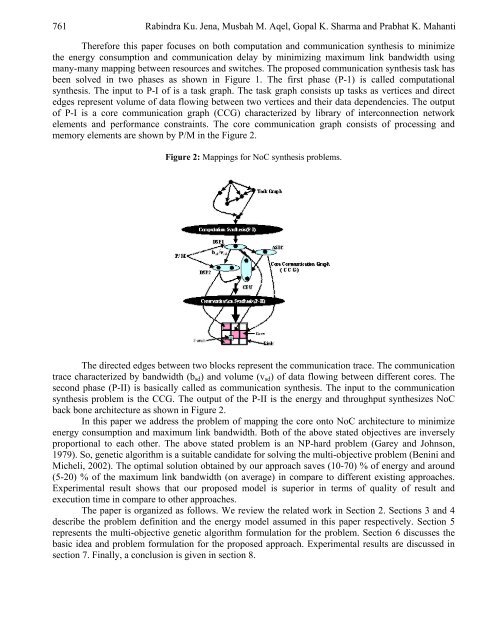European Journal of Scientific Research - EuroJournals
European Journal of Scientific Research - EuroJournals
European Journal of Scientific Research - EuroJournals
Create successful ePaper yourself
Turn your PDF publications into a flip-book with our unique Google optimized e-Paper software.
761 Rabindra Ku. Jena, Musbah M. Aqel, Gopal K. Sharma and Prabhat K. Mahanti<br />
Therefore this paper focuses on both computation and communication synthesis to minimize<br />
the energy consumption and communication delay by minimizing maximum link bandwidth using<br />
many-many mapping between resources and switches. The proposed communication synthesis task has<br />
been solved in two phases as shown in Figure 1. The first phase (P-1) is called computational<br />
synthesis. The input to P-I <strong>of</strong> is a task graph. The task graph consists up tasks as vertices and direct<br />
edges represent volume <strong>of</strong> data flowing between two vertices and their data dependencies. The output<br />
<strong>of</strong> P-I is a core communication graph (CCG) characterized by library <strong>of</strong> interconnection network<br />
elements and performance constraints. The core communication graph consists <strong>of</strong> processing and<br />
memory elements are shown by P/M in the Figure 2.<br />
Figure 2: Mappings for NoC synthesis problems.<br />
The directed edges between two blocks represent the communication trace. The communication<br />
trace characterized by bandwidth (bsd) and volume (vsd) <strong>of</strong> data flowing between different cores. The<br />
second phase (P-II) is basically called as communication synthesis. The input to the communication<br />
synthesis problem is the CCG. The output <strong>of</strong> the P-II is the energy and throughput synthesizes NoC<br />
back bone architecture as shown in Figure 2.<br />
In this paper we address the problem <strong>of</strong> mapping the core onto NoC architecture to minimize<br />
energy consumption and maximum link bandwidth. Both <strong>of</strong> the above stated objectives are inversely<br />
proportional to each other. The above stated problem is an NP-hard problem (Garey and Johnson,<br />
1979). So, genetic algorithm is a suitable candidate for solving the multi-objective problem (Benini and<br />
Micheli, 2002). The optimal solution obtained by our approach saves (10-70) % <strong>of</strong> energy and around<br />
(5-20) % <strong>of</strong> the maximum link bandwidth (on average) in compare to different existing approaches.<br />
Experimental result shows that our proposed model is superior in terms <strong>of</strong> quality <strong>of</strong> result and<br />
execution time in compare to other approaches.<br />
The paper is organized as follows. We review the related work in Section 2. Sections 3 and 4<br />
describe the problem definition and the energy model assumed in this paper respectively. Section 5<br />
represents the multi-objective genetic algorithm formulation for the problem. Section 6 discusses the<br />
basic idea and problem formulation for the proposed approach. Experimental results are discussed in<br />
section 7. Finally, a conclusion is given in section 8.

















